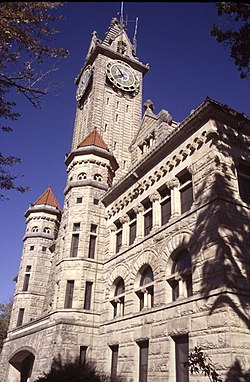
A courthouse or court house is a structure which houses judicial functions for a governmental entity such as a state, region, province, county, prefecture, regency, or similar governmental unit. A courthouse is home to one or more courtrooms, the enclosed space in which a judge presides over a court, and one or more chambers, the private offices of judges. Larger courthouses often also have space for offices of judicial support staff such as court clerks and deputy clerks.

The Belmont County Courthouse is located at 101 West Main Street in St. Clairsville, Ohio, United States. It sits on the highest point in the St. Clairsville area and is thus visible from Interstate 70 and many other points in the Ohio Valley. It is a contributing property in the St. Clairsville Historic District, which was added to the National Register of Historic Places in 1969.

The Santa Barbara County Courthouse (Courthouse) is a well-known example of Spanish Colonial Revival architecture and is located in Santa Barbara, Santa Barbara County, California. Started in 1926 and completed in 1929, the Courthouse originally served as Santa Barbara County’s (County) superior courthouse, jail, and administrative office. The Courthouse was included on the National Register of Historic Places in 1981, was made a City of Santa Barbara Historic Landmark in 1982, a California Historical Landmark in 2004, and a National Historic Landmark in 2005. Over the years, most County administrative offices were relocated to other County buildings. The current Courthouse houses six County Superior Court rooms, the Mural Room, the County Hall of Records, the County Public Defender's Office, offices of the County General Services Department, and the McMahon Law Library. The Courthouse is open to the public and is a popular site for community gatherings and weddings. Architect Charles Willard Moore called it the "grandest Spanish Colonial Revival structure ever built," and the prime example of Santa Barbara's adoption of Spanish Colonial as its civic style.

The Washington County Courthouse in Hillsboro, Oregon is the courthouse for Washington County, Oregon, in the United States. Washington County was established in 1843 and the first government building was finished in 1852. The current courthouse was built in 1928 with an addition and renovations to the structure in 1972. Currently the building houses courtrooms, the county sheriff's dispatch, staff offices, and the office of the district attorney. The county jail was previously attached to the courthouse.

The Beltrami County Courthouse is a historic government building in Bemidji, Minnesota, United States. It was erected in 1902 as the seat of government for Beltrami County. District court functions relocated in 1974 to the newly completed Beltrami County Judicial Center immediately to the southwest, and the historic courthouse has been remodeled to house government offices. The old courthouse was listed on the National Register of Historic Places in 1988 for its state-level significance in the themes of architecture and politics/government. It was nominated for its status in Beltrami County as its long-serving center government and as its most prominent example of public architecture and Beaux-Arts style.

The Fulton County Courthouse, built in 1870, is a historic courthouse building located in Wauseon, Ohio. On May 7, 1973, it was added to the National Register.

The Courthouse of Crawford County, Ohio, is a landmark of the county seat, Bucyrus, Ohio. The courthouse was built in 1854 on East Mansfield Street by architect Harlan Jones and was added to the National Register of Historic Places on 1985-02-28 as a part of the Bucyrus Commercial Historic District.

The Hancock County Courthouse is a historic courthouse in Findlay, Ohio, United States. Built between 1886 and 1888, it was listed on the National Register of Historic Places in 1973.

The Federal Building and Post Office is a historic main post office, courthouse, and Federal office building at 271-301 Cadman Plaza East in the Downtown Brooklyn neighborhood of Brooklyn in New York City. The original building was the Brooklyn General Post Office, and is now the Downtown Brooklyn Station, and the north addition is the courthouse for the United States Bankruptcy Court for the Eastern District of New York, and is across the street from and in the jurisdiction of the main courthouse of the United States District Court for the Eastern District of New York, the Theodore Roosevelt United States Courthouse. It also houses offices for the United States Attorney, In 2009, the United States Congress renamed the building the Conrad B. Duberstein United States Bankruptcy Courthouse, after chief bankruptcy judge Conrad B. Duberstein.
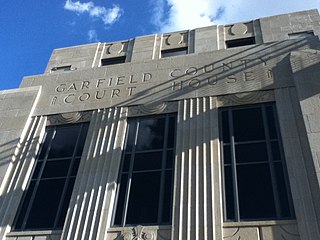
The Garfield County Courthouse is a historic courthouse building located in Enid, Oklahoma. It is on the National Register of Historic Places both individually and as a part of the Enid Downtown Historic District.

The Jasper County Courthouse in Rensselaer, Indiana is a building from 1898. It was listed on the National Register of Historic Places in 1983 and is located in the Rensselaer Courthouse Square Historic District. The Jasper County Courthouse was erected in 1898 at a total cost of $141,731.94. It is located in the center of the Courthouse Square bounded by Washington, Cull en, Harrison and Van Rensselaer Streets. The Courthouse Square, itself, is defined by a retaining wall of concrete, about 18" high and a foot wide. There are steps leading from the street to the walks leading to all four entrances to the building.
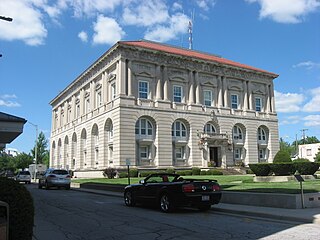
The Putnam County Courthouse is a historic governmental building in downtown Ottawa, Ohio, United States. A two-story building, located at 245 E. Main Street, it was built in 1912 in the Beaux-Arts style of architecture.
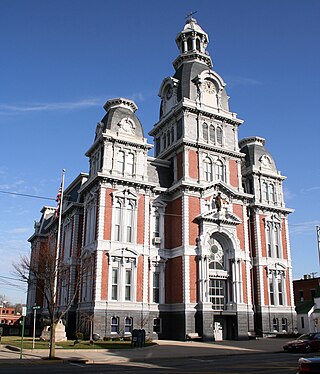
The Van Wert County Courthouse is a historic governmental building in downtown Van Wert, Ohio, United States. Located at 121 E. Main Street, the courthouse is a Second Empire structure built in 1876. It is Van Wert County's third courthouse: when the county was established, the village of Willshire was designated the county seat; Van Wert was made the seat in 1838, and a courthouse-and-jail complex was built in that community in the following year.
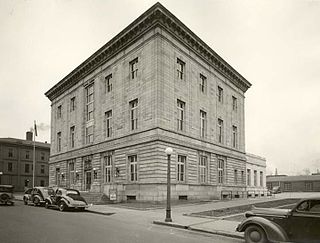
The William H. Natcher Federal Building and United States Courthouse is a courthouse of the United States District Court for the Western District of Kentucky located in Bowling Green, Kentucky. Built in 1912, the building was renamed for U.S. Representative William Huston Natcher in 1994. It is located at 241 East Main Street.

The Washington County Courthouse is the name of a current courthouse and that of a historic one in Fayetteville, Arkansas, the county seat of Washington County. The historic building, built in 1905, was listed on the National Register of Historic Places in 1972. The historic courthouse is the fifth building to serve Washington County, with the prior buildings located on the Historic Square where the Old Post Office is today. The building is one of the prominent historic buildings that compose the Fayetteville skyline, in addition to Old Main.

The Holmes County Courthouse is a historic government building in Millersburg, Ohio, United States. Built in the late nineteenth century, it has been designated a historic site because of its architectural importance.

The Wood County Museum, located in Bowling Green, Ohio, is the original site of the Wood County Infirmary also known as the Wood County Home or the Poor Farm. This structure was the home to poor, mentally- ill, physically disabled and anyone in need of public assistance who were residents of Wood County.

The Perry County Courthouse is a historic government building in the city of New Lexington, Ohio, United States. Built near the end of the nineteenth century after the end of a county seat war, it is the fifth courthouse to serve Perry County, and it has been named a historic site because of its imposing architecture.

The former Bowling Green Post Office is a historic governmental facility in downtown Bowling Green, Ohio, United States. Constructed in the early twentieth century, this post office features an unusual combination of distinctive architectural styles, and it has been named a historic site.
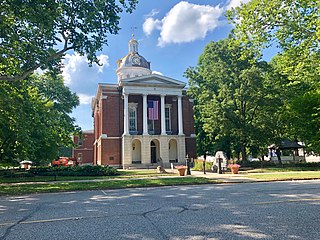
Nineteenth-century American county courthouse architecture was used in buildings designed to house judicial and administrative functions in styles such as Federal, Neoclassical, Italianate, Second Empire, and Romanesque Revival, which were adapted to local building materials and styles to accommodate local needs. Over the course of the nineteenth century, the typical American county courthouse became more specialized than its eighteenth century predecessor, featuring increased usage of interior passageways and multiple levels and stairwells to facilitate a greater level of formality to court proceedings than could often be achieved through earlier examples which were centered around a single room on the ground floor. The gradual replacement of courtroom fittings associated with the English common law with those associated with American adversarial statute law, along with the use of clock towers, statuary, turrets, domes, and other architectural features became increasingly central to the iconography of local American public life, which represented at once the ideal of equal and impartial justice before the law in criminal and civil disputes, as well as the more wealth based and paternalistic ideal of justice represented by such cases as probations of estates, recording of deeds and property boundaries, assessments of taxes, enforcements of debts, evictions, and transfers of slaves.
